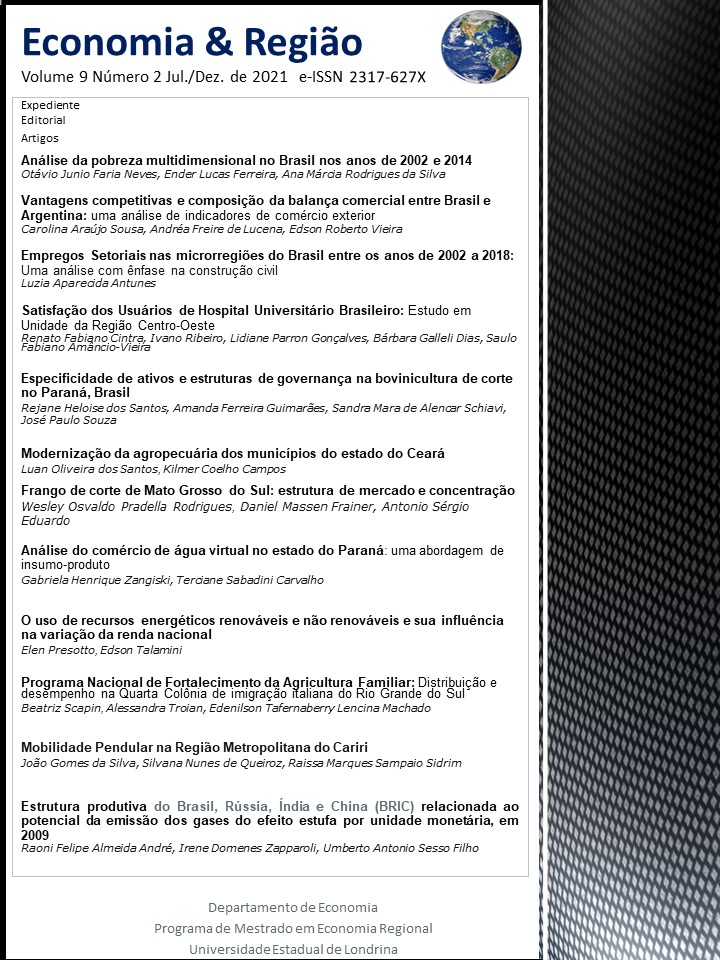Sectorial jobs in the microregions of Brazil between the years 2002 to 2018: An analysis with emphasis on civil construction
DOI:
https://doi.org/10.5433/2317-627X.2021v9n2p55Keywords:
Concentration, Jobs, DynamismAbstract
Civil construction is a sector that exerts great influence on the number of jobs in the country, offering jobs in several segments. Much of the labor demanded by the sector has low education, thus the sector has the capacity to employ people at different levels of qualification, which consequently ends up boosting the dynamism of the economy, through the overflows of income that are obtained. The importance that this sector has for the Brazilian economy The objective of the research is to map the concentration of employment in the civil construction sector for Brazilian micro-regions between the years 2002 to 2018, where it is intended to verify which are the micro-regions that most employ in civil construction and whether that number of jobs has undergone any type of location change or in that structural period using the shif-share method. A micro-region of Altamira, located in the state of Pará, has the largest concentration of the number of jobs in construction for the period 2002-2018. Only 13.95% of the micro-regions Specialized competitive advantage, 22.36% were identified as unskilled competitive advantage, 47.94% with unskilled competitive disadvantage.Downloads
References
BON, R. The Future of International Construction: secular patterns of growth and decline. Habitat International, v. 16, n. 3, p. 19-128, 1992.
CIBIC. Câmara Brasileira da Indústria da Construção, 2018. Disponível em: http://www.cbicdados.com.br/menu/pib-e-investimento/pib-brasil-e-construcao-civil. Acesso em: 11 nov. 2019.
CHAU, N.; MUR, J. M.; BENAMGHAR, L.; SIEGFRIED, C.; DANGELZER, J. L.; FRANCAIS, M; SOURDOT, A. Relationships between some individual characteristics and occupational accidents in the construction industry. Journal of occupational health, v. 44, n.3, p. 131-139. 2002.
DELGADO, A. P.; GODINHO, I. M. Medidas de localização das actividades e de especialização regional. In: COSTA, J. S. (Coord.). Compêndio de economia regional. Coimbra: APDR, 2020. Cap. 20, p.723-742.
ESTEBAN-MARQUILLAS, J. M. Shift-and share analysis revisited. Regional and Urban Economics, v. 2, p. 249-261, 1972.
FIRJAN. Indice Firjan de Desenvolvimento municipal, 2018. Disponível em: acesso em: https://www.firjan.com.br/ifdm/destaques/estados/ifdm-2018-rj-firjan-crise-economica-afetou-emprego-e-renda-em-62-das-cidades-fluminenses.htm. Acesso em: 11 nov. 2019.
FIRJAN. Indice Firjan de Desenvolvimento municipal, 2014. Disponível em: acesso em: file:///C:/Users/Kelly/Downloads/Construcao-Civil-versao-completa.pdf. Acesso em: 11 nov. 2019.
HADDAD, P. R. Medidas de localização e especialização. In: HADDAD, P. R. (Org.). Economia regional: teorias e métodos de análise. Fortaleza: BNB. ETENE, 1989. cap.4, p.225- 247.
HIRATA, F. "Minha Casa, Minha Vida": Política habitacional e de geração de emprego ou aprofundamento da segregação urbana?. Revista Aurora, v. 2, n. 2, p.1-11, 2009.
IRIART, J. A. B.; OLIVEIRA, R. P. D.; XAVIER, S. D. S.; COSTA, A. M. D. S.; ARAÚJO, G. R. D.; SANTANA, V. S. Representações do trabalho informal e dos riscos à saúde entre trabalhadoras domésticas e trabalhadores da construção civil. Ciência & Saúde Coletiva, v.13, n. 1, p. 165-174. 2008.
IBGE. Instituto Brasileiro de Geografia e Estatística, 2018. Disponível em: https://agenciadenoticias.ibge.gov.br/agencia-noticias/2012-agencia-de-noticias/noticias/17080-regiao-norte-lidera-alta-no-custo-da-construcao-civil-em-setembro. Acesso em: 12 nov. 2019.
IBGE. Instituto Brasileiro de Geografia e Estatística, 2014. Disponível em: https://agenciadenoticias.ibge.gov.br/agencia-sala-de-imprensa/2013-agencia-de-noticias/releases/14701-asi-em-2012-sudeste-concentrava-552-do-pib-do-pais-e-o-df-tinha-o-maior-pib-per-capita. Acesso em: 12 nov. 2019.
IBGE. Instituto Brasileiro de Geografia e Estatística, 2014. Disponível em: https://agenciadenoticias.ibge.gov.br/agencia-noticias/2012-agencia-de-noticias/noticias/23559-custos-da-construcao-civil-encerram-2018-com-alta-de-4-41. Acesso em: 12 nov. 2019.
GONÇALVES JUNIOR. C. A.; DUTRA, R. D. L.; LOPES, R. L.; RODRIGUES, R. L. The impact of the" My House, My Life" Housing Program in the Brazilian economy: an analysis of input-output. Ambiente Construído, v.14,n.1, p. 177-189.2014.
KURESKI, R.; RODRIGUES, R. L.; MORETTO, A. C.; SESSO FILHO, U. A.; HARDT, L. P. A. O macrossetor da construção civil na economia brasileira em 2004. Ambiente Construído, v.8, n.1, p.7-19. 2008.
MTE. Ministério do Trabalho, 2020. Disponível em: http://pdet.mte.gov.br/acesso-online-as-bases-de-dados . Acesso em: 07 jun. 2020.
MLINGA, R. S.; LEMA, N. M. Informal contractors in Tanzania-their characteristics and reasons for informality. In: 2nd International Conference on Construction in Developing Countries: Challenges facing the construction industry in developing countries. Gaborone, Botswana. 2000.
NERI, M. C. Trabalho, educação e juventude na construção civil. FGV Centro de Politicas Sociais. 2011.
OLIVEIRA, O. F. D.; MEDEIROS, P. N. D.; Pereira, W. E. N. Uma breve descrição da construção civil no brasil, destacando o emprego formal e os estabelecimentos no Nordeste. Seminário de Pesquisa do Centro de Ciências Sociais Aplicadas, 20. 2015
OLIVEIRA, V. F.; OLIVEIRA, E. A. D. A. Q. O papel da Indústria da Construção Civil na organização do espaço e do desenvolvimento regional. IV Congresso Internacional de Cooperação Universidade-Indústria .Vol. 4, 2012.
DE OLIVEIRA RODRIGUES, V.; SORIA, S. Faces do "novo" desenvolvimento: o trabalho na construção civil em Suape (PE/Brasil). Espacio abierto: cuaderno venezolano de sociología, v.29, n.1, p.205-224, 2020.
PIACENTI, C. A.; ALVES, L. R.; DE LIMA, J. F. O perfil locacional do emprego setorial no Brasil. Revista Econômica do Nordeste, v.39, n.3, p. 482-502, 2008.
PIACENTI, C. A.; LIMA. J. F.; ALVES. L. R.; RIPPEL, R. Indicadores de localização, especialização e estrutura regional. In: PIACENTI, C. A., LIMA. J. F (Org.). Análise regional: metodologia e indicadores. Curitiba: Camões, 2012. cap.3, p.33- 49.
SANTOS, C. V.; HILGEMBERG, C. M. D. A. T. Emprego formal no setor de serviços nos municípios dos Campos Gerais do Paraná: uma análise para o período 2000-2010. Planejamento e Políticas Públicas, v.51, n.1, p. 255-284, 2018.
SANTOS, V. M. D. A economia do Sudeste paraense: evidências das transformações estruturais. Repositório do conhecimento do IPEA. 2017.
Downloads
Published
How to Cite
Issue
Section
License
Copyright (c) 2021 Economia & Região

This work is licensed under a Creative Commons Attribution 4.0 International License.
Economia & Região adota a Licença Creative Commons Attribution CC-BY 4.0 International, portanto, os direitos autorais relativos aos artigos publicados são do(s) autor(es), que cedem à Revista Economia & Região o direito de exclusividade de primeira publicação.
Sob essa licença é possível: Compartilhar - copiar e redistribuir o material em qualquer suporte ou formato. Adaptar - remixar, transformar, e criar a partir do material, atribuindo o devido crédito e prover um link para a licença e indicar se mudanças foram feitas.




















